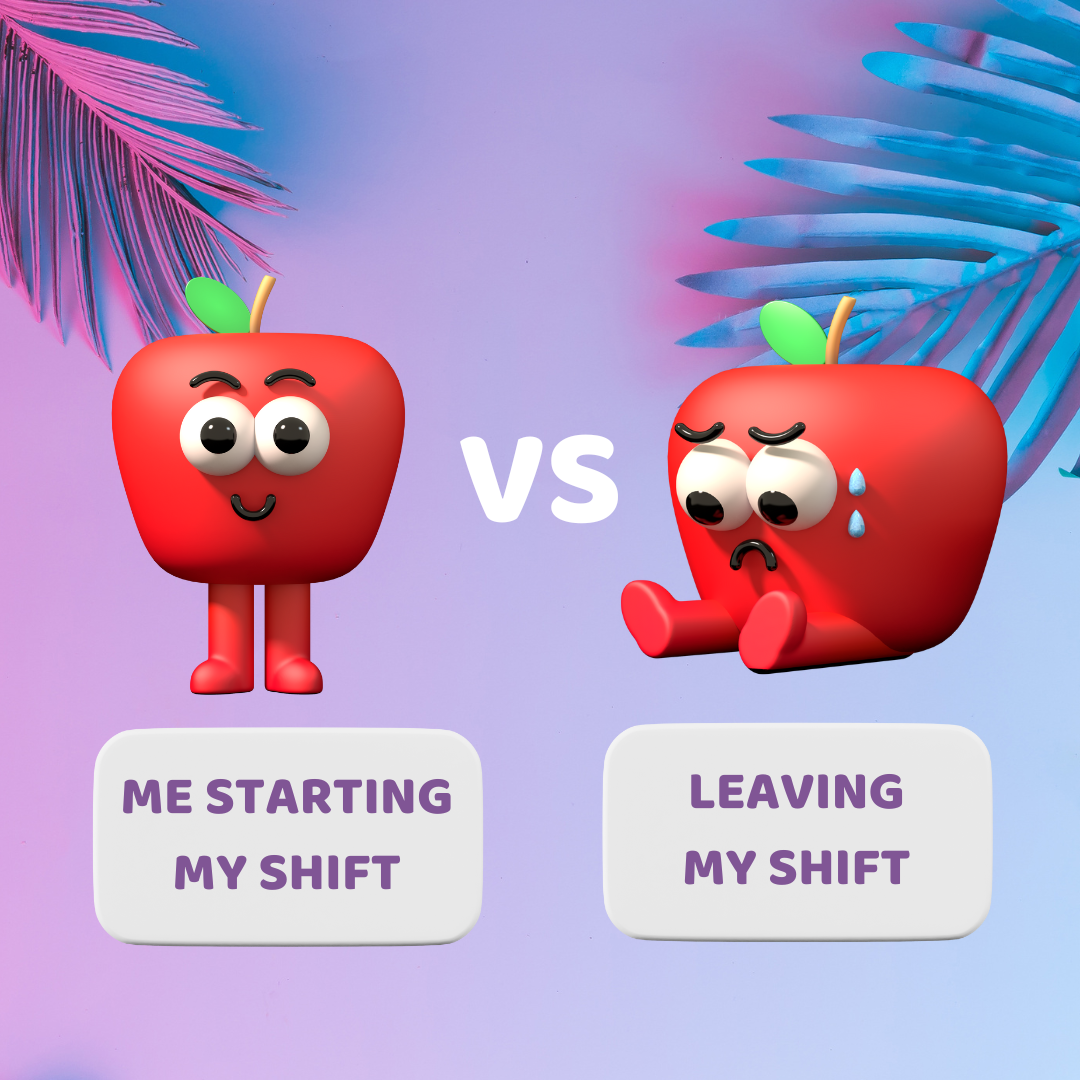The Best Practices for Any Work Shift
Dominate any schedule! Our guide equips you with best practices for thriving on every work shift, from 9-to-5 to nights and rotations. Discover the best practices to manage any work shift with ease.

The dynamics of work shifts and their hours greatly influence the operational aspects of businesses, making it a subject of paramount importance in the contemporary business landscape.
Balancing work shifts and hours is crucial for employers and employees for obvious reasons:
- it helps ensure optimal productivity
- it contributes to maintaining a healthy work-life balance.
But this topic is more intricate than it seems as it covers a wide spectrum, from understanding the various types of work shifts to comprehending the implications these schedules have on employees' well-being and business efficiency.

In this post, we'll comprehensively explore the complexities of work shifts, offering insights and guidance on navigating them.
What is a Work Shift?
Work shifts are the organized time during which different groups of workers perform their tasks.
Aside from the usual Monday-through-Friday, 9-to-5 grind, work shifts imply that you clock in and get down to business outside those standard office hours.
They are designed to cover the operational hours of workplaces for the purpose of:
- continuous production
- service availability.
Shift work means having different work schedules to cover all the hours of the day, so a business can stay open or keep things running whenever needed.
Work Shift Fact Box
- The concept of work shifts🕰️ has existed since ancient times. The ancient Romans and Greeks used shift work for their military and guard duties.
- The term "shift work" was first coined during the Industrial Revolution🔥 in the 19th century, when factories started operating around the clock to meet increasing production demands.
- Night shifts🌙 were introduced in the early 20th century to accommodate continuous production in various industries, such as steel mills and chemical plants.
- The traditional 9-to-5 workday⏳ originated in the United States in the 1920s when Henry Ford implemented a 40-hour workweek for his employees.
- In many countries, workers who regularly work night shifts are legally entitled to additional pay or compensation💰 due to the health risks of working irregular hours.
- Some countries have laws that limit the number of consecutive hours⚠️ an individual can work, ensuring that employees receive adequate rest between shifts.
- The rise of the gig economy and remote work💻 has led to a shift away from traditional work schedules as more workers seek flexible hours and greater autonomy.

Common Work Shift Types
Day Shift 🌞
This is the most traditional work period, usually starting in the morning and ending in the afternoon (e.g., 9 AM to 5 PM), aligning with standard business hours.
Night Shift 🌜
Also known as the graveyard/third/midnight shift, it typically covers the late evening to early morning hours, often starting from 9 or 10 PM and ending at 5 or 6 AM, to continue operations after the day shift ends.
Swing Shift🌇
Swing shifts fall between the day and night shifts. They often cover the late afternoon to late evening hours, such as 4 PM to midnight, catering to businesses that peak in customer activity during these times.
Rotating Shift 🔁
Workers alternate between day, night, and swing shifts, either weekly, bi-weekly, or as determined by their employer, to distribute the burden of less desirable hours.
Split Shift🕒🔛🕗
This shift involves two distinct work periods each day, with a long break in between. It is commonly found in sectors like hospitality, where there are peak periods followed by lulls.
Fixed Shift📅
Opposite of rotating shifts, a fixed shift maintains consistent working hours for employees over a long period, allowing for a stable routine.
On-Call Shift (Emergency Shift) 📞
Workers are not scheduled for specific hours but must be available if called in, often used in healthcare and emergency services.
Seasonal Shift🌷☀️🍁❄️
These shifts are designed for high-demand seasons, such as holiday retail or summer tourism, and may have varying hours and durations.
Flex Shift⏳➡️🔄
Offers flexibility in start and end times, accommodating personal needs or preferences of employees while still fulfilling work hour requirements. This shift prioritizes employee needs for flexibility, aiming to support work-life balance.
Custom Shift🛠️
Employees work according to a custom schedule tailored to the business's needs, allowing for flexibility in coverage. Custom shifts focus more on the business's needs, ensuring staffing aligns with operational demands.
Compressed Workweek 🗜️
This schedule allows employees to work their full-time hours in fewer days, often four 10-hour days instead of five 8-hour days.
Weekend Shift📅🔚
This shift specifically covers weekends, catering to businesses that operate primarily on those days (e.g., restaurants, hospitality).

9/80 Shift9️⃣➗8️⃣0️⃣
Employees work 80 hours over nine business days, with a regular weekend off, providing a longer break between shifts.
This shift specifically covers weekends, catering to businesses that operate primarily on those days (e.g., restaurants and hospitality).
10-Hour Shift⏰
A common shift in industries requiring 24-hour coverage, lasting from 6 a.m. to 2 p.m. or 2 p.m. to 10 p.m.
Temporary Shift⏳
Employees work temporarily, often for special projects or to cover for absent employees.
Challenges of Work Shifts

Organizing various work shifts involves several challenges for employers and businesses.
Day Shift Challenges
- Aligning with standard business hours can limit operational flexibility.
- May lead to increased labor costs due to the need for a large number of employees working simultaneously.
- Requires significant workspace to accommodate all employees.
Night Shift Challenges
- Higher wage rates are often necessary due to unsociable working hours.
- Increased health and safety concerns, given the unconventional working hours.
- Employee retention can be difficult, as not everyone is willing or able to work night shifts.
Swing Shift Challenges
- Necessitates careful planning to meet customer demand during peak activity periods.
- Requires a dynamic workforce management system to accommodate fluctuating staffing needs.
Rotating Shift Challenges
- Can disrupt employees' work-life balance and circadian rhythms.
- May lead to decreased job satisfaction and productivity due to the constant change in work schedules.
Split Shift Challenges
- Challenges employee satisfaction due to long breaks between work periods, complicating personal time management.
- Particularly prevalent in sectors like hospitality, where peak periods are followed by lulls.
Fixed Shift Challenges
- Balancing the benefits of routine and predictability against the need for operational flexibility can be challenging.
- Not always suitable for industries with variable demand.
On-Call Shift (Emergency Shift) Challenges
- Can lead to unpredictability in staffing, making it hard to manage personal life and work commitments for employees.
- Requires employees to be flexible and available at short notice, which can be stressful and lead to burnout.
Seasonal Shift Challenges
- Demand for labor can fluctuate significantly, requiring careful planning to ensure sufficient staffing during peak seasons without overstaffing during off-peak times.
- Training temporary or seasonal workers quickly and efficiently can be challenging.
Flex Shift Challenges
- Balancing the flexibility needs of employees with the business's operational needs can be complex.
- Requires advanced scheduling technology or processes to manage individualized work schedules effectively.
Custom Shift Challenges
- Customizing shifts to meet business needs and employee preferences requires significant administrative effort and sophisticated scheduling systems.
- Maintaining fairness and transparency in shift assignments can be challenging.
Compressed Workweek Challenges
- Extended workdays can lead to increased employee fatigue and decreased productivity over time.
- Not all roles or industries can accommodate the longer day, shorter week format without impacting service delivery or operational efficiency.
Weekend Shift Challenges
- Finding employees willing to work primarily on weekends can be difficult, as it may conflict with personal and family time.
- May require higher wage rates or additional benefits to attract and retain staff.
9/80 Shift Challenges
- Implementing a schedule with a day off every other week can complicate payroll and overtime calculations.
- Not all businesses can afford to have employees out of the office for an extra day in the rotation, which can impact operations.
10-Hour Shift Challenges
- Longer shifts can lead to quicker burnout and health issues for employees due to the extended work hours.
- Balancing coverage and ensuring adequate rest periods between shifts is crucial to maintain employee health and safety.
Temporary Shift Challenges
- Integrating temporary workers into the team and bringing them up to speed can require significant effort.
- Managing the quality and consistency of work from temporary employees can be challenging.
11 Strategies to Optimize Work Shifts for Efficiency & Employee Satisfaction

Implement Advanced Time Tracking Software
⏳Utilize Advanced Time Tracking Solutions: Incorporating sophisticated time tracking software can enhance efficiency in managing work shifts.
These tools facilitate:
- streamlined scheduling
- accurate time tracking
- efficient shift swapping.
They also offer demand forecasting capabilities, enabling managers to adjust staffing levels effectively in response to workload variations.
Implement a Comprehensive Time-off Management System
🌴Deploy a Systematic Approach for Time-off Requests: Establishing a robust management system is crucial for efficient work shift management.
This includes:
- setting transparent guidelines for submitting requests
- required notice periods
- the criteria for approval or denial.
A well-managed system ensures minimal operational disruption while accommodating employees' personal needs.

Establish Transparent Shift Management Policies
📋Formulate and Communicate Clear Shift Guidelines: It is essential to create transparent policies for shift assignments, exchanges, and overtime.
This clarity:
- fosters fairness and transparency in shift management
- reduces conflicts and misunderstandings among team members.

Engage Employees in the Scheduling Process
Empower Employees in Schedule Planning: Allowing employees to have a say in their schedules within operational constraints enhances job satisfaction and reduces turnover.
This could involve approving shift swaps or accommodating preferences for specific shifts where possible.
Ensure Equitable Shift Distribution
🔢Guarantee Equal Shift Allocation: To prevent favoritism, ensure that all employees distribute shifts fairly, including weekends and holidays.
The equitable distribution supports a harmonious work environment and mitigates feelings of resentment.

Optimize Shift Handovers
🔄Plan Overlapping Shifts for Smooth Transitions: Scheduling overlap periods between shifts ensures continuous operation.
It also allows for the handover of critical information, minimizing disruptions in workflow.
Leverage Data for Informed Shift Scheduling
📊Utilize Analytics for Shift Planning: Employ data analysis on sales, customer traffic, and workload to forecast busy times and accordingly plan shifts.
A data-driven strategy aligns staffing with actual demand and enhances efficiency.
Provide Advance Notice of Work Schedules
🔊Communicate Work Schedules Early: Issuing work schedules in advance supports employees in balancing their work and personal commitments.
This approach reduces stress and increases job satisfaction.
Foster Versatility Through Cross-Training
🗓️Enhance Flexibility with Cross-Trained Staff: Training employees in various organizational roles increases scheduling flexibility.
Taking this approach makes managing absences and spikes in demand easier.
Manage and Optimize Overtime
🔍Monitor and Regulate Overtime: Keeping a close eye on overtime distribution and necessity helps prevent burnout and manage labor costs.
Hiring additional staff may be warranted if there's a consistent excess workload.

Incorporate Employee Feedback into Shift Planning
⚙️Adapt Based on Employee Feedback: Actively seeking and incorporating employee feedback into the shift management strategy can unveil opportunities for improvement and address concerns that may not be evident to management.
Wrap Up
Work shifts come in many forms; navigating them effectively is vital for any business.
Implementing the suggested tactics can ensure smooth operations, a satisfied workforce, and, ultimately, a thriving business.
The dedication to precision in time tracking is crucial, as it lays the foundation for efficiency and accountability in working schedules. TMetric is a fortress of precision, ensuring that every hour spent on the job is accurately logged and managed.


